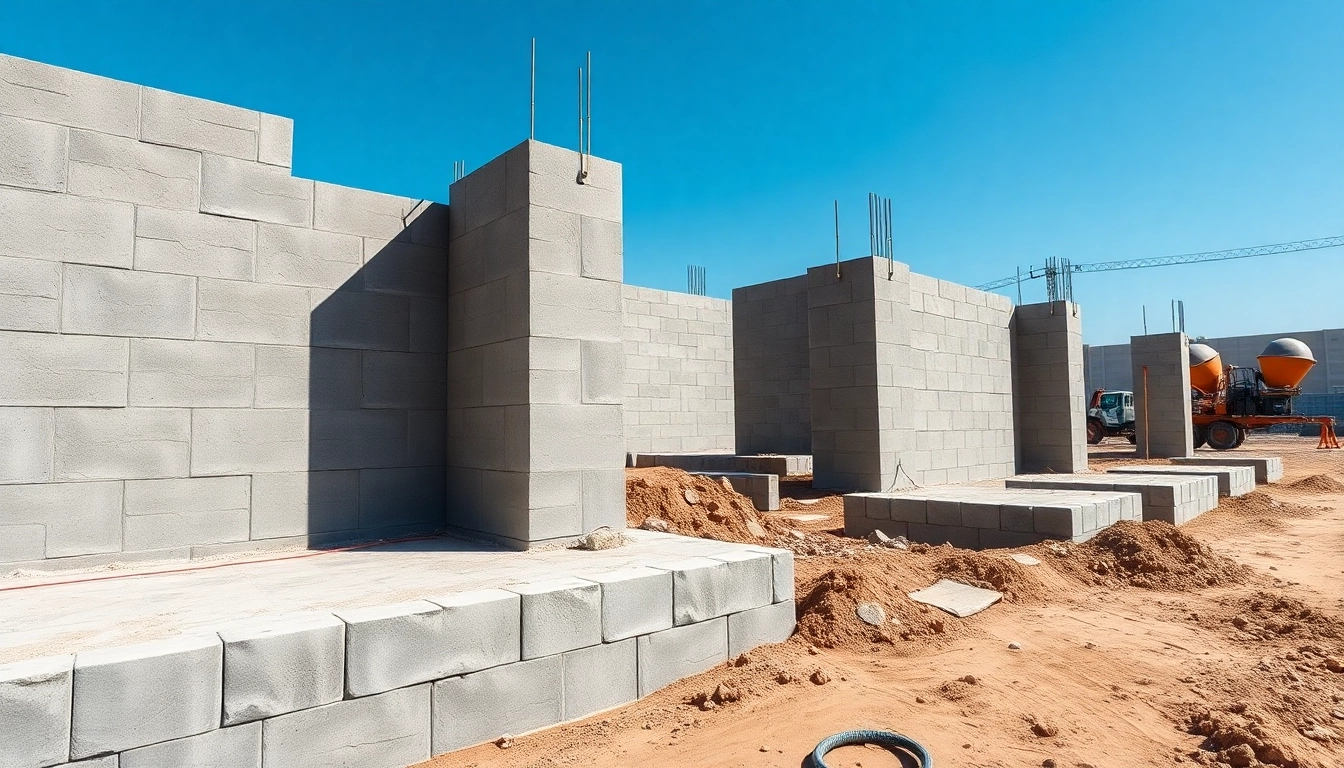Understanding Footing and Block Walls
When embarking on any construction project, understanding the foundational components that ensure stability is essential. This is especially true for footing and Block walls, which serve as critical structural elements. Footings, the concrete bases laid below ground level, support walls and redistribute loads. Block walls, typically made from concrete masonry units (CMUs), provide robust vertical support and enclose spaces. This article will delve into the essential aspects of footings and block walls, including their components, types, significance, planning, construction techniques, challenges, and maintenance guidelines.
Components of Footing and Block Walls
Understanding the components involved in footings and block walls is essential for effective design and construction. The primary components include:
- Footings: The concrete base usually poured below the frost line that supports the foundation, distributing weight across the soil.
- Block Units: Solid or hollow concrete blocks that interlock to create a sturdy wall structure.
- Reinforcement: Steel rebar or mesh may be embedded in the concrete to enhance load-bearing capacity.
- Mortar: A mixture used to bond block units together, providing shear resistance and integrity to the wall.
- Drainage Systems: Essential for managing water flow around the footings and block walls to prevent hydrostatic pressure build-up.
Types of Footing Used in Construction
There are various types of footings utilized in construction, each suited for different soil conditions, load requirements, and structural designs:
- Strip Footings: Continuous strips of concrete that support walls in low-load residential buildings.
- Spread Footings: Wide footings that distribute loads over a larger area, ideal for heavier structures.
- Isolated Footings: Footings created for individual columns, minimizing concrete usage while effectively distributing column loads.
- Matt Foundations: Large, thick slabs of concrete that support multi-story buildings, where soil conditions may be uncertain.
Importance of Block Walls in Structural Integrity
Block walls play a significant role in the overall structural integrity of a building. Here are several reasons why:
- Load Distribution: Block walls provide excellent load-bearing capabilities, effectively distributing weight from the roof and upper floors.
- Resistance to Elements: Concrete block walls are highly resistant to fire, rot, and pests, contributing to building longevity.
- Thermal Efficiency: With proper insulation, block walls can enhance a building’s thermal performance, reducing energy costs.
- Acoustic Insulation: The density of block walls aids in soundproofing, making them suitable for residential and commercial construction.
Planning for Footing and Block Walls
Proper planning is crucial to the success of constructing footing and block walls. The following steps will help ensure optimal results:
Site Assessment for Optimal Footing
Conducting a thorough site assessment is essential before laying footings. Key considerations include:
- Soil Testing: Determine the type and bearing capacity of the soil through engineering tests to evaluate its strength and load-bearing capabilities.
- Topography: Assess the land’s slope, drainage patterns, and proximity to water sources to ensure adequate runoff and avoid flooding.
- Surrounding Structures: Analyze the impact of neighboring buildings on soil stability and footings design.
Design Considerations for Block Walls
When designing block walls, several factors should be taken into account to ensure their effectiveness and durability:
- Height and Thickness: The wall’s height and thickness depend on the load it needs to bear and local building codes.
- Reinforcement Needs: Decide on the need for vertical and horizontal reinforcements within the blocks based on structural demands.
- Waterproofing: Incorporate moisture barriers to prevent water damage and mold growth, especially in below-grade walls.
Regulatory Compliance and Building Codes
Ensuring compliance with local regulations and building codes is imperative for any construction project. Key steps in this area include:
- Research Local Codes: Investigate applicable codes that govern footing sizes, wall designs, and materials.
- Permit Acquisition: Secure all necessary permits before construction, which may involve submitting detailed planning and engineering documents.
- Inspections: Schedule inspections at various construction stages to verify compliance and quality assurance.
Construction Techniques for Footing and Block Walls
Understanding and implementing effective construction techniques is vital for the integrity and durability of footings and block walls:
Step-by-Step Guide to Laying Footings
Follow this guide to properly lay footings:
- Excavation: Dig a trench according to the specifications determined during site assessment.
- Setting Forms: Construct formwork to hold the poured concrete in shape.
- Reinforcement Placement: Place rebar or mesh within the forms, adhering to the specified loading requirements.
- Pouring Concrete: Mix and pour concrete into the forms, ensuring it fully encapsulates the reinforcement.
- Curing: Allow the concrete to cure properly, minimizing cracks and optimizing strength.
Efficient Methods for Installing Block Walls
Installing block walls requires precision and technique:
- Base Preparation: Ensure the footing is level and stable before starting the block wall installation.
- Mortar Mixing: Prepare mortar according to specified ratios, ensuring it’s workable and pliable.
- Laying the First Course: Start with the first row, ensuring it’s level and aligned carefully.
- Subsequent Courses: Apply mortar between blocks, staggering joints for structural integrity as you build upward.
- Finishing Touches: Once the desired height is achieved, apply any finishing mortar or treatment to edges as needed.
Tools and Materials Required for Construction
Ensure you have the following tools and materials on hand to facilitate your footing and block wall construction:
- Tools: Concrete mixer, trowels, level, tape measure, rebar cutter, and masonry saw.
- Materials: Concrete (for footings), concrete blocks (for walls), reinforcement bars, mortar, and water proofing membranes.
Common Challenges in Footing and Block Wall Construction
While building footings and block walls, several challenges can arise. Understanding these challenges allows for effective mitigation strategies:
Addressing Soil-Related Issues
Soil conditions can pose significant challenges in construction. Addressing these issues is vital:
- Weak Soils: Utilize soil stabilization techniques and consider deeper footings to reach solid ground.
- Expansive Soils: Include moisture control measures to manage shrink-swell potential that affects structural stability.
Mitigating Water Damage Risks
Water damage-related issues can compromise footings and block walls. Preventative measures include:
- Proper Drainage: Install drainage systems that effectively divert water away from the foundation.
- Moisture Barriers: Use water-resistant materials in wall constructions, especially for below-grade applications.
Ensuring Long-Term Durability
The longevity of footings and block walls depends on various factors:
- Quality Materials: Use high-quality concrete blocks and aggregates to resist wear and tear over time.
- Regular Maintenance: Inspect and repair any cracks, leaks, or signs of degradation promptly to prevent further damage.
Maintenance and Upkeep of Footing and Block Walls
Regular maintenance is essential for extending the life and integrity of footings and block walls:
Best Practices for Inspecting Structural Components
Routine inspections should be performed to identify potential issues early:
- Visual Check: Regularly monitor visible surfaces for cracks or shifting.
- Record Keeping: Document findings and maintenance actions taken to track the history of repairs and inspections.
Repair Techniques for Common Problems
Swift responses to identified issues can prevent larger concerns:
- Crack Filling: Use epoxies or hydrophilic sealants to fill cracks in both footings and block walls.
- Reinforcement Addition: In cases of compromised integrity, reinforce structural components with additional rebar or external bracing.
Enhancing the Lifespan of Footing and Block Walls
Several strategies can further enhance the longevity of wall and footing systems:
- Regular Cleaning: Keep walls and surrounding areas clean from debris, vegetation, and standing water.
- Proper Grading: Ensure the ground slopes away from walls to prevent water accumulation around the foundation.



